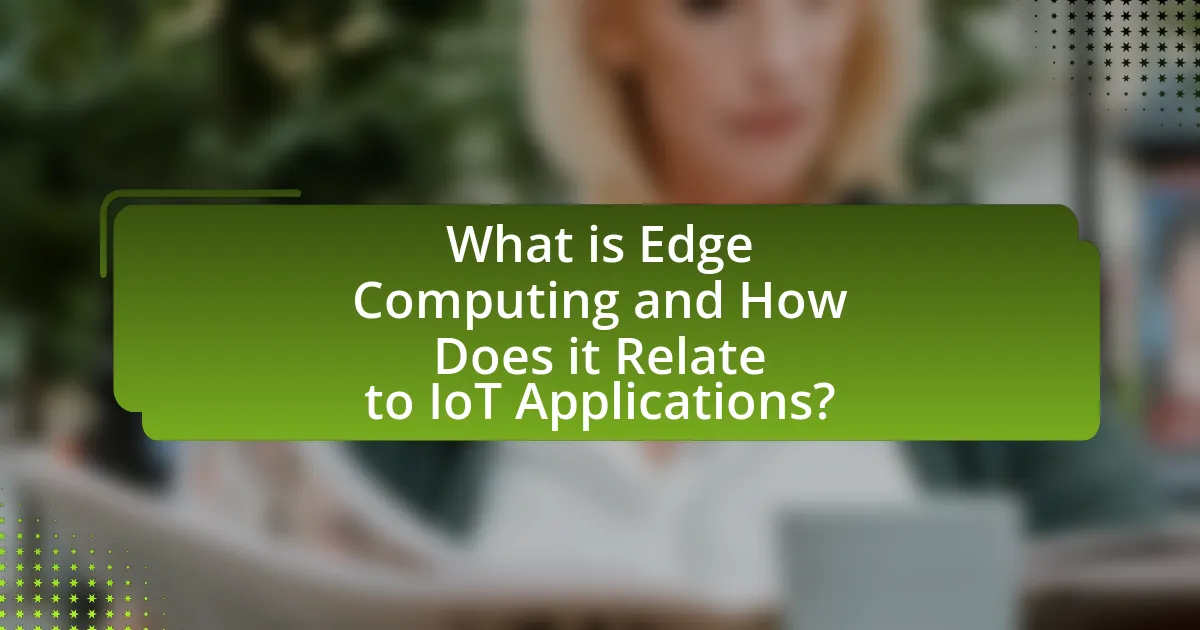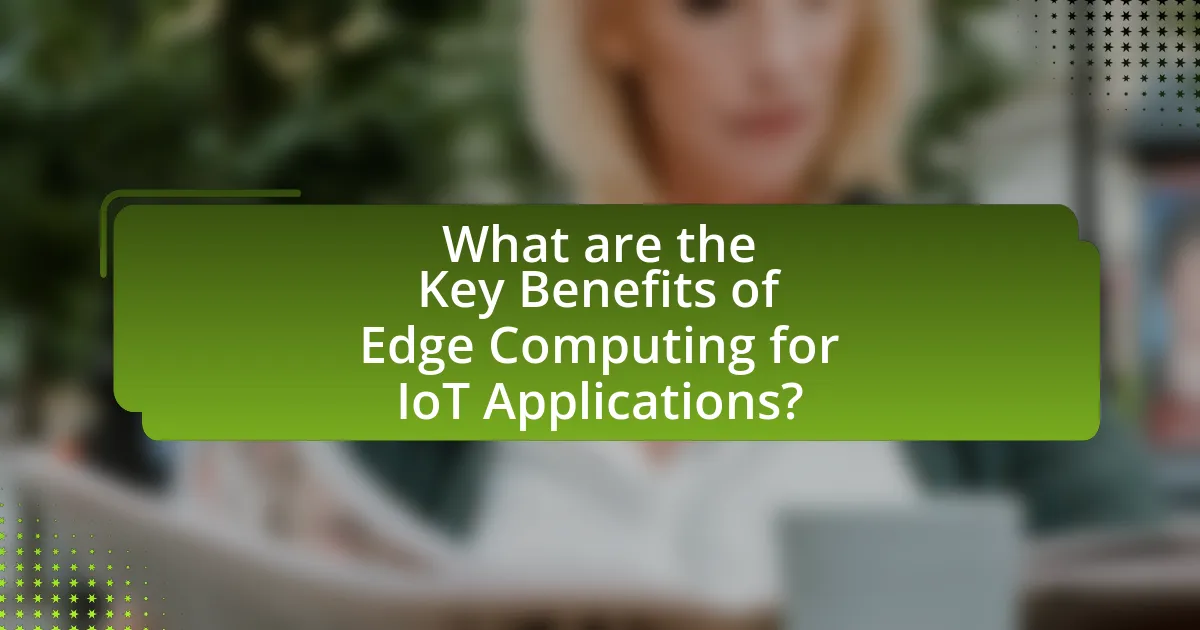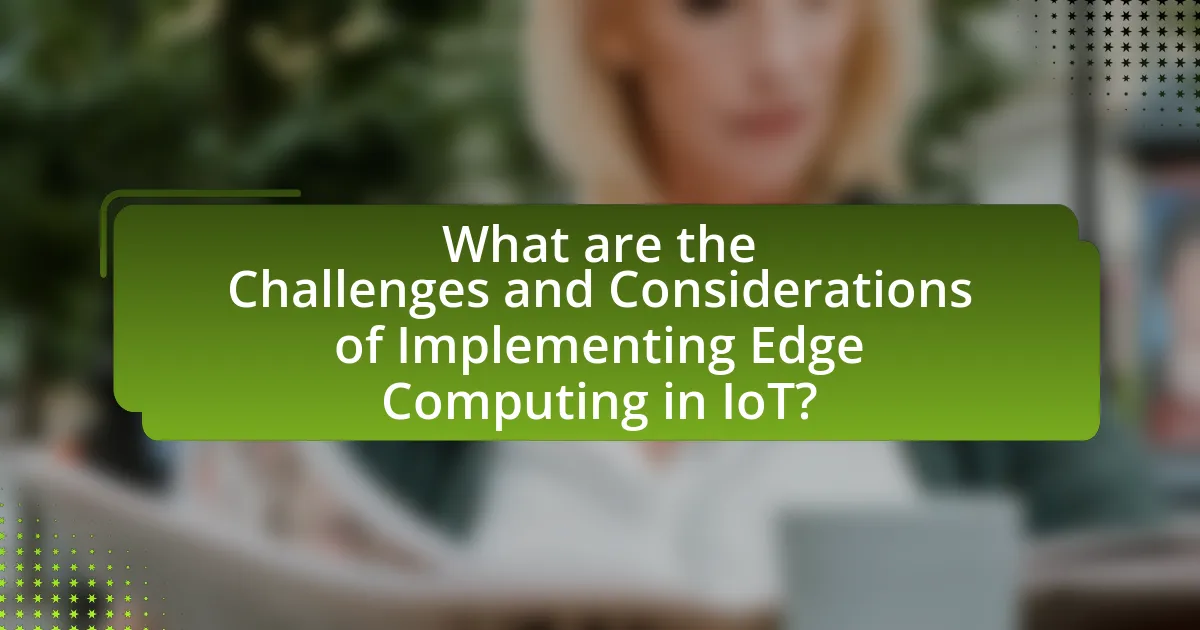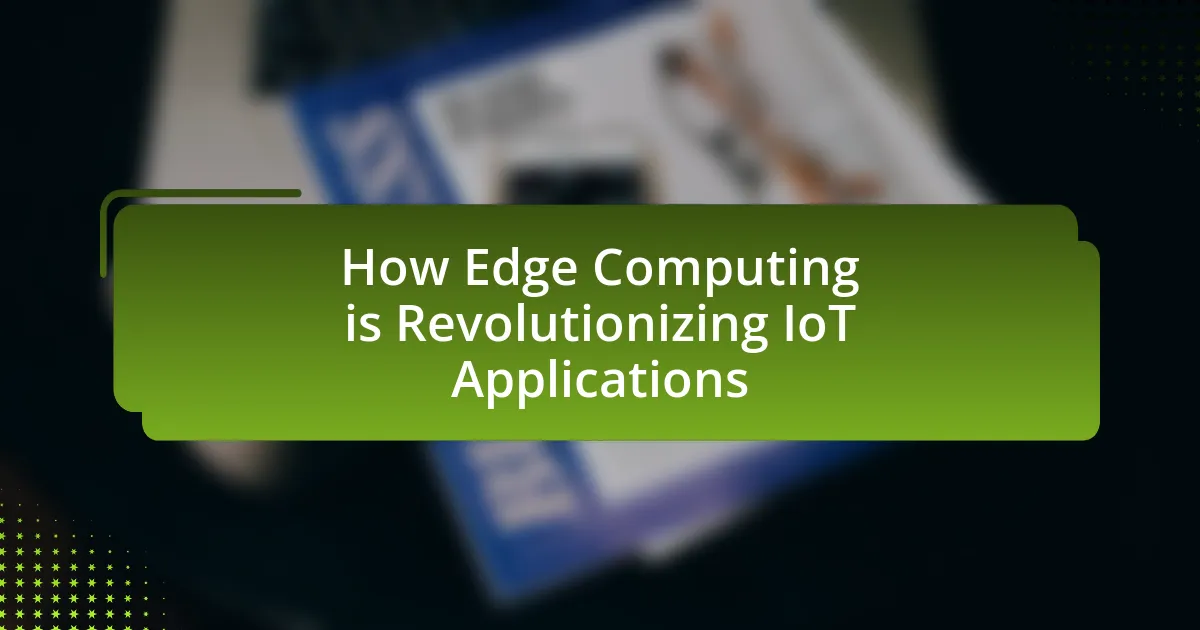Edge computing is a distributed computing model that enhances Internet of Things (IoT) applications by processing data closer to its source, thereby reducing latency and bandwidth usage. This technology is crucial for real-time data analysis in various sectors, including smart cities, healthcare, and autonomous vehicles. Key benefits of edge computing include improved performance of IoT devices, enhanced data security, and efficient data handling, which collectively address challenges such as latency, bandwidth limitations, and data privacy. As the number of connected devices continues to rise, edge computing is becoming essential for optimizing IoT operations and driving innovation across industries.

What is Edge Computing and How Does it Relate to IoT Applications?
Edge computing is a distributed computing paradigm that brings computation and data storage closer to the location where it is needed, thereby reducing latency and bandwidth use. This approach is particularly relevant to Internet of Things (IoT) applications, as it enables real-time data processing and analysis at the edge of the network, rather than relying solely on centralized cloud servers. For instance, in smart cities, edge computing allows for immediate processing of data from sensors, which enhances decision-making for traffic management and public safety. The integration of edge computing with IoT is supported by the increasing number of connected devices, projected to reach 75 billion by 2025, necessitating efficient data handling to optimize performance and responsiveness.
How does Edge Computing enhance the performance of IoT devices?
Edge Computing enhances the performance of IoT devices by processing data closer to the source, which reduces latency and bandwidth usage. This proximity allows for real-time data analysis and quicker decision-making, essential for applications like autonomous vehicles and smart manufacturing. According to a study by Gartner, edge computing can reduce latency by up to 75%, significantly improving the responsiveness of IoT systems. Additionally, by minimizing the amount of data sent to centralized cloud servers, edge computing alleviates network congestion, further optimizing the performance of IoT devices.
What are the key features of Edge Computing that benefit IoT?
Edge Computing enhances IoT through reduced latency, improved bandwidth efficiency, enhanced data security, and real-time processing capabilities. By processing data closer to the source, edge computing minimizes the time it takes for data to travel to centralized cloud servers, which is crucial for applications requiring immediate responses, such as autonomous vehicles and industrial automation. This proximity also alleviates bandwidth strain by limiting the amount of data sent to the cloud, allowing for more efficient use of network resources. Furthermore, edge computing enhances data security by keeping sensitive information local, reducing the risk of data breaches during transmission. According to a report by Gartner, by 2025, 75% of enterprise-generated data will be created and processed outside the centralized data center, underscoring the growing importance of edge computing in IoT ecosystems.
How does latency reduction impact IoT applications?
Latency reduction significantly enhances the performance of IoT applications by enabling real-time data processing and decision-making. When latency is minimized, devices can communicate and respond to events almost instantaneously, which is crucial for applications such as autonomous vehicles, industrial automation, and remote healthcare monitoring. For instance, a study by Cisco indicates that reducing latency from 100 milliseconds to 10 milliseconds can improve the responsiveness of IoT systems, leading to better user experiences and increased operational efficiency. This improvement allows IoT applications to function effectively in time-sensitive scenarios, ultimately driving innovation and adoption across various industries.
Why is Edge Computing becoming essential for IoT?
Edge Computing is becoming essential for IoT because it enables real-time data processing closer to the source of data generation, reducing latency and bandwidth usage. By processing data at the edge, IoT devices can respond more quickly to events, which is critical for applications like autonomous vehicles and industrial automation. According to a report by Gartner, by 2025, 75% of enterprise-generated data will be created and processed outside a centralized data center, highlighting the shift towards decentralized computing models that support IoT scalability and efficiency.
What challenges in IoT does Edge Computing address?
Edge Computing addresses several challenges in IoT, including latency, bandwidth limitations, data privacy, and real-time processing. By processing data closer to the source, Edge Computing significantly reduces latency, enabling faster response times for IoT devices. This is crucial for applications like autonomous vehicles and industrial automation, where milliseconds can impact safety and efficiency. Additionally, Edge Computing alleviates bandwidth constraints by minimizing the amount of data transmitted to centralized cloud servers, which is particularly beneficial in environments with limited connectivity. Furthermore, it enhances data privacy and security by keeping sensitive information local, reducing the risk of exposure during transmission. Overall, Edge Computing effectively mitigates these challenges, facilitating more efficient and secure IoT operations.
How does Edge Computing improve data security for IoT devices?
Edge computing enhances data security for IoT devices by processing data closer to the source, thereby reducing the risk of data breaches during transmission. By minimizing the distance data travels to centralized cloud servers, edge computing limits exposure to potential interception and attacks. Additionally, edge devices can implement localized security measures, such as encryption and access controls, which can be tailored to specific environments and threats. This localized approach allows for faster response times to security incidents, as data does not need to traverse the internet to reach a central server for analysis. Studies have shown that edge computing can reduce the attack surface by keeping sensitive data on-site, thus decreasing the likelihood of unauthorized access.

What are the Key Benefits of Edge Computing for IoT Applications?
Edge computing significantly enhances IoT applications by reducing latency, improving bandwidth efficiency, and increasing data security. By processing data closer to the source, edge computing minimizes the time it takes for data to travel to centralized cloud servers, which is crucial for real-time applications such as autonomous vehicles and industrial automation. According to a report by Gartner, by 2025, 75% of enterprise-generated data will be created and processed outside a centralized data center, underscoring the shift towards edge computing. Additionally, edge computing alleviates bandwidth constraints by filtering and processing data locally, sending only relevant information to the cloud, which optimizes network usage. Furthermore, it enhances security by keeping sensitive data on local devices rather than transmitting it over the internet, thereby reducing exposure to potential cyber threats.
How does Edge Computing improve data processing efficiency?
Edge Computing improves data processing efficiency by processing data closer to the source of generation, which reduces latency and bandwidth usage. By decentralizing data processing, Edge Computing minimizes the need to transmit large volumes of data to centralized cloud servers, thereby speeding up response times and enabling real-time analytics. For instance, a study by Cisco indicates that Edge Computing can reduce data transmission costs by up to 75% and improve application performance by decreasing latency to milliseconds. This localized processing capability is particularly beneficial for IoT applications, where timely data analysis is critical for decision-making and operational efficiency.
What role does real-time data processing play in IoT?
Real-time data processing is crucial in IoT as it enables immediate analysis and response to data generated by connected devices. This capability allows for timely decision-making, enhancing operational efficiency and improving user experiences. For instance, in smart manufacturing, real-time data processing can detect equipment failures instantly, allowing for proactive maintenance and minimizing downtime. According to a report by McKinsey, companies that implement real-time data analytics can achieve up to a 20% increase in productivity. Thus, real-time data processing is integral to maximizing the potential of IoT applications.
How does Edge Computing reduce bandwidth usage for IoT?
Edge Computing reduces bandwidth usage for IoT by processing data closer to the source, minimizing the amount of data that needs to be transmitted to centralized cloud servers. This localized data processing allows for filtering and analysis of data at the edge, which means only relevant or summarized information is sent over the network. For instance, a study by Cisco indicates that up to 94% of IoT data can be processed at the edge, significantly decreasing the volume of data transmitted and thus conserving bandwidth.
What industries are most impacted by Edge Computing in IoT?
The industries most impacted by Edge Computing in IoT include manufacturing, healthcare, transportation, and smart cities. In manufacturing, edge computing enhances real-time data processing for predictive maintenance and operational efficiency. In healthcare, it enables remote patient monitoring and faster data analysis for critical care. Transportation benefits from improved traffic management and vehicle-to-everything (V2X) communication, while smart cities leverage edge computing for efficient resource management and enhanced public safety. These industries experience significant advancements due to reduced latency and improved data handling capabilities provided by edge computing.
How is Edge Computing transforming healthcare IoT applications?
Edge computing is transforming healthcare IoT applications by enabling real-time data processing at the source of data generation, which significantly reduces latency and enhances decision-making. This technology allows medical devices, such as wearables and remote monitoring systems, to analyze patient data locally rather than sending it to centralized cloud servers, thus improving response times in critical situations. For instance, a study published in the Journal of Medical Internet Research highlighted that edge computing can decrease data transmission delays by up to 50%, facilitating timely interventions in patient care. Additionally, edge computing enhances data security and privacy by minimizing the amount of sensitive information transmitted over networks, which is crucial in healthcare settings where data breaches can have severe consequences.
What are the implications of Edge Computing in smart cities?
Edge computing significantly enhances the efficiency and responsiveness of smart cities by processing data closer to the source, thereby reducing latency and bandwidth usage. This localized data processing allows for real-time analytics and decision-making, which is crucial for applications such as traffic management, public safety, and environmental monitoring. For instance, a study by the International Data Corporation (IDC) predicts that by 2025, 75% of enterprise-generated data will be processed outside centralized data centers, underscoring the shift towards edge computing in urban environments. Additionally, edge computing supports the integration of Internet of Things (IoT) devices, enabling smarter infrastructure and improved citizen services, ultimately leading to more sustainable and resilient urban ecosystems.

What are the Challenges and Considerations of Implementing Edge Computing in IoT?
Implementing edge computing in IoT faces several challenges and considerations, including security vulnerabilities, interoperability issues, and resource constraints. Security is a primary concern, as edge devices can be more susceptible to attacks due to their distributed nature; a report by the Cybersecurity & Infrastructure Security Agency highlights that 70% of IoT devices have known vulnerabilities. Interoperability is another challenge, as diverse devices and protocols can complicate integration, leading to inefficiencies. Additionally, resource constraints, such as limited processing power and battery life in edge devices, can hinder performance and scalability. These factors must be addressed to ensure successful implementation of edge computing in IoT environments.
What technical challenges do organizations face with Edge Computing?
Organizations face several technical challenges with Edge Computing, including data security, network reliability, and device management. Data security is critical as edge devices often process sensitive information, making them vulnerable to cyberattacks; a report by Cybersecurity Ventures predicts that cybercrime will cost the world $10.5 trillion annually by 2025, emphasizing the need for robust security measures. Network reliability is another challenge, as edge computing relies on stable connections to transmit data between devices and centralized systems; disruptions can lead to data loss or degraded performance. Additionally, managing a diverse array of edge devices can complicate deployment and maintenance, as organizations must ensure compatibility and efficient operation across various hardware and software platforms.
How can organizations overcome interoperability issues in Edge Computing?
Organizations can overcome interoperability issues in Edge Computing by adopting standardized protocols and frameworks that facilitate communication between diverse devices and systems. Implementing open standards, such as MQTT or CoAP, allows for seamless data exchange across various platforms. Additionally, utilizing middleware solutions can bridge gaps between different technologies, ensuring compatibility and enhancing data integration. Research indicates that organizations that prioritize interoperability through these methods can significantly reduce integration costs and improve system efficiency, as evidenced by a study from the International Journal of Information Management, which highlights that standardized approaches lead to a 30% increase in operational effectiveness in IoT deployments.
What are the costs associated with deploying Edge Computing solutions?
The costs associated with deploying Edge Computing solutions include hardware expenses, software licensing fees, network infrastructure investments, and ongoing maintenance costs. Hardware expenses typically involve purchasing edge devices, servers, and sensors, which can range from a few hundred to several thousand dollars depending on the scale and complexity of the deployment. Software licensing fees may include costs for operating systems, applications, and management tools, which can vary widely based on vendor and functionality. Network infrastructure investments are necessary to ensure reliable connectivity between edge devices and central systems, potentially requiring upgrades to existing networks or the installation of new ones. Ongoing maintenance costs encompass technical support, software updates, and hardware replacements, which can accumulate over time. According to a report by Gartner, organizations can expect to allocate 10-30% of their IT budgets to edge computing initiatives, highlighting the significant financial commitment required for successful deployment.
How can organizations ensure successful integration of Edge Computing in IoT?
Organizations can ensure successful integration of Edge Computing in IoT by implementing a robust architecture that supports real-time data processing and analytics at the edge. This involves deploying edge devices that can handle data locally, reducing latency and bandwidth usage, which is critical for applications requiring immediate responses, such as autonomous vehicles or industrial automation.
Furthermore, organizations should prioritize interoperability among devices and platforms to facilitate seamless communication and data exchange. According to a report by Gartner, by 2025, 75% of enterprise-generated data will be created and processed outside the centralized data center, highlighting the necessity for edge solutions that can efficiently manage this data flow.
Additionally, investing in security measures is essential, as edge computing introduces new vulnerabilities. A study by McKinsey indicates that organizations that prioritize cybersecurity in their IoT strategies can reduce the risk of breaches by up to 50%.
Lastly, continuous monitoring and optimization of edge computing deployments will help organizations adapt to changing requirements and improve performance over time.
What best practices should be followed for Edge Computing implementation?
Best practices for Edge Computing implementation include ensuring data security, optimizing network bandwidth, and maintaining low latency. Data security is critical as edge devices often handle sensitive information; implementing encryption and secure access controls can mitigate risks. Optimizing network bandwidth is essential to reduce congestion and improve performance, which can be achieved through data filtering and local processing. Maintaining low latency is vital for real-time applications; deploying edge nodes closer to data sources can significantly enhance response times. These practices are supported by industry standards and case studies demonstrating improved efficiency and security in edge computing environments.
How can organizations measure the success of Edge Computing in IoT?
Organizations can measure the success of Edge Computing in IoT by evaluating key performance indicators (KPIs) such as latency reduction, bandwidth savings, and data processing efficiency. For instance, a study by Gartner indicates that implementing edge computing can reduce latency by up to 75%, significantly enhancing real-time data processing capabilities. Additionally, organizations can assess the volume of data processed locally versus sent to the cloud, with successful edge implementations typically achieving a higher percentage of local processing, thus saving bandwidth costs. Furthermore, monitoring application performance metrics, such as response times and system uptime, provides concrete evidence of improved operational efficiency attributed to edge computing.
What are the Future Trends of Edge Computing in IoT Applications?
The future trends of edge computing in IoT applications include increased adoption of artificial intelligence at the edge, enhanced security measures, and the integration of 5G technology. As organizations seek to process data closer to the source, AI algorithms will be deployed on edge devices to enable real-time analytics and decision-making, reducing latency and bandwidth usage. Enhanced security measures will focus on protecting data at the edge, as more devices connect to the internet, necessitating robust encryption and authentication protocols. Furthermore, the rollout of 5G networks will facilitate faster data transmission and support a higher density of connected devices, driving the growth of edge computing in IoT applications. According to a report by MarketsandMarkets, the edge computing market is projected to grow from $3.6 billion in 2020 to $15.7 billion by 2025, highlighting the increasing importance of this technology in IoT ecosystems.
How will advancements in AI influence Edge Computing for IoT?
Advancements in AI will significantly enhance Edge Computing for IoT by enabling real-time data processing and decision-making at the edge of networks. This capability reduces latency, as AI algorithms can analyze data locally rather than relying on centralized cloud servers, which can be slow and bandwidth-intensive. For instance, AI-driven edge devices can process sensor data from IoT applications, such as smart cities or industrial automation, allowing for immediate responses to changing conditions. According to a report by Gartner, by 2025, 75% of enterprise-generated data will be created and processed outside the centralized data center, highlighting the growing importance of AI in optimizing edge computing environments for IoT applications.
What emerging technologies are likely to shape the future of Edge Computing?
Emerging technologies likely to shape the future of Edge Computing include 5G networks, artificial intelligence (AI), and the Internet of Things (IoT). 5G networks enhance data transmission speeds and reduce latency, enabling real-time processing at the edge. AI facilitates advanced analytics and decision-making directly on edge devices, improving efficiency and responsiveness. The proliferation of IoT devices generates vast amounts of data that require localized processing to minimize bandwidth usage and enhance security. These technologies collectively drive the evolution of Edge Computing, making it integral to the future of IoT applications.
What Practical Tips Can Help Organizations Leverage Edge Computing for IoT?
Organizations can leverage edge computing for IoT by implementing the following practical tips: first, they should prioritize data processing at the edge to reduce latency and bandwidth usage, enabling real-time analytics and decision-making. For instance, deploying edge devices that can process data locally minimizes the need to send large volumes of data to centralized cloud servers, which can lead to delays and increased costs.
Second, organizations must ensure robust security measures are in place at the edge, as edge devices can be vulnerable to cyber threats. Implementing encryption, secure access controls, and regular software updates can protect sensitive data and maintain system integrity.
Third, organizations should adopt a modular architecture that allows for easy scalability and integration of new IoT devices. This flexibility enables organizations to adapt to changing business needs and technological advancements without significant overhauls of their existing infrastructure.
Finally, investing in training and development for staff on edge computing technologies is essential. Knowledgeable personnel can better manage and optimize edge computing solutions, ensuring that organizations fully realize the benefits of this technology in their IoT applications.



